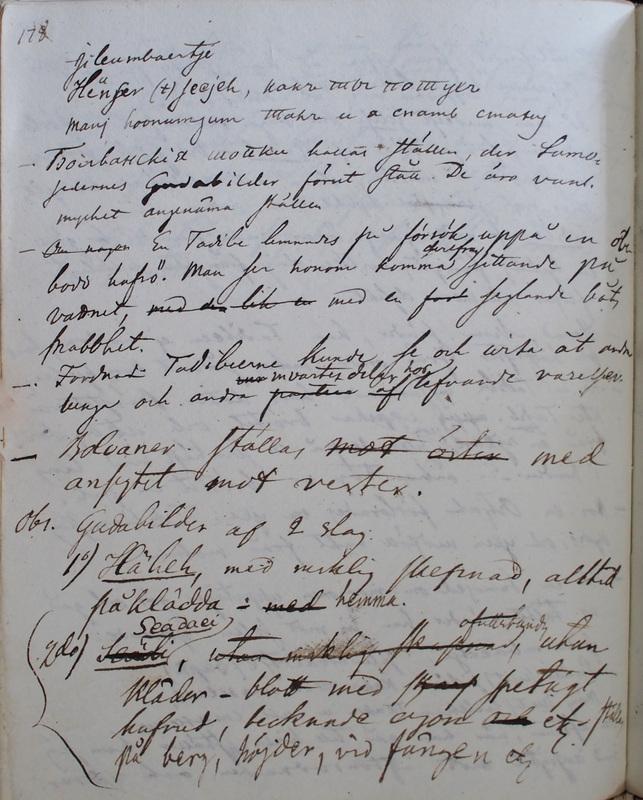Ethnographiska, historiska och statistiska anmärkningar. 178
Title
Ethnographiska, historiska och statistiska anmärkningar. 178
Description
|
Jileumbaertje
Heunzer (t)seejeh, какъ ты потухъ Manj hoonumjum Такъ и я спать стану. TN Илевямбэртя Ханзер сея Мань хонумюмʹ ʻJiljevjambertja As you go out I go to bed.ʻ See [Jileumbartje] (RL, TaS, KL)
|
Jileumbaertje |
|
Болванскiя шопки
kallas ställen der Samo-Bolvanskaja sopka ʻBolvan hill’ is a Russian term for Nenets sacred places that have wooden or stone idols and traces of sacrifices in them. The kinds of hills are often clearly distinguishable from the environment by their shape and they are often also named beautiful or pleasant, as Castrén does here. TN хэбидяʹ я or хэхэʹ я.
jedernes Gudabilder förut stått. De äro vanl[igen]. mycket angenäma ställen. |
Bolvanskija šopki is the name of the places where the Samoyed idols stood before. They are often very pleasant places. |
|
Om någon
En tadibe
lemnades på försök uppå en obe-Shamanic belief narrative. See also note [för en tadibe] and [Samojediska sagor 3]
bodd hafsö. Man ser honom komma derifrån sittande på vattnet, med en for seglande båtens snabbhet. |
A Tadibe was left on trial on an uninhabited island in the sea. They saw him coming from there sitting on the water, with the speed of a sailing boat. |
| Fordnade Tadibeerne kunde se och wisa åt andra lunga och andra mvartes[människovarelsers] delar hos lefvande varelser. |
The ancient Tadibes could see and show to other men parts of the lungs and other parts of living human beings. |
| Bolvaner ställas mot östen med ansigtet mot vester. |
Bolvans are set with their face pointing to the west. |
| Obs. Gudabilder af
2 slag:
1) Häheh, med msklig[mänsklig] skepnad, alltid påklädda hemma. |
NB: Idols are of two kinds:
1) Hähe, with a human shape, always dressed at home. |
| 2) Seädi Seadaei utan msklig[mänsklig] skepnad ofullständig, utan kläder - blott med spetsigt hufvud, tecknade ögon etc. Ställas på berg, höjden, vid fången etc. |
2) Seadaei, incomplete, without clothes – only with a pointed head, marked eyes, etc. They are laid on mountains, heights, by the catch, etc. |

